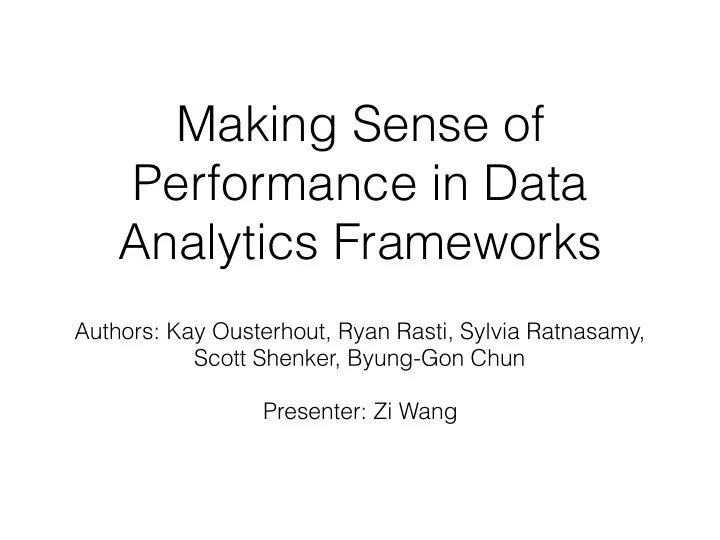

Making Sense of Performance in Data Analytics Frameworks Authors: Kay Ousterhout, Ryan Rasti, Sylvia Ratnasamy, Scott Shenker, Byung-Gon Chun Presenter: Zi Wang
Why? • Commonly Accepted mantras • Network • IO/disk • Straggler
Takeways • Network can reduce job completion time by at 2% • I/O optimizations lead to <19% reduction in completion time • Many straggler causes can be identified and fixed • CPU is in general the bottleneck
Outline • Methodology • Results • Threats to validity
What is the job’s bottleneck Network Compute Disk Task x: may be bottlenecked on tasks different resources at different times Time t: different tasks may be bottlenecked on different resources time
Blocked Time Analysis • Time when task is blocked on one resource (e.g network) • Blocked time analysis: how much faster would the job complete if tasks never blocked on the resource?
An Example of Blocked Time Analysis for Network (1) Measure time when tasks are blocked on the network tasks (2) Simulate how job completion time would change
Blocked time analysis: how quickly could a job have completed if a resource were infinitely fast? Scheduler would have moved Task 2 to slot 2
Experiments Setting • Big Data Benchmark, 50 queries, 50GB Data, 5 machines • TPC-DS (Scale 5000), 260 queries, 850GB Data, 20 machines • Production, 30 queries, tens of GB Data, 9 machines
Experiments Setting • All three workloads are Spark-SQL workloads • Coarse-grained analysis of traces from Facebook, Google, Microsoft are used for sanity check
Are jobs network-light?
Analysis • Queries often shuffle and output much less data than they read • However, the result seems inconsistent from previous work…
Two Reasons • Incomplete Metric Only look at shuffle time • • Conflation of CPU and network time Sending data over the network has an associated CPU cost •
Analysis for I/O • Compressed data is used, CPU is traded for I/O • Spark is written in Scala. Data read must be deserialized to Java Objects.
Role of Straggler • The median reduction from eliminating straggler < 10% • Common causes: garbage collection, I/O • Many Stragglers are caused by inherent factors like output size
Threats to Validity • Only One Framework (Spark) • Small cluster sizes • Only three workloads
Related work • Instead of using Spark, using Naiad can achieve up to 3x speedups going from 1G network to 10G network • Spark is also memory-efficient, leveraging “in- memory” computation • Modern hardware (I/O, network links) are also more improved compared to CPU
Comparison to Pivot Tracing • Static v.s. Dynamic • Resource Directed Analysis v.s. Crossing Boundaries Analysis
References • Making Sense of Performance in Data Analytics Frameworks • Pivot Tracing: Dynamic Causal Monitoring for Distributed Systems • The impact of fast networks on graph analytics • Project Tungsten: Bringing Apache Spark Closer to Bare Metal
“The only way to get ahead is to find errors in conventional wisdom.” –Larry Ellison
Recommend
More recommend